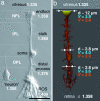Muller cells are living optical fibers in the vertebrate retina
- PMID: 17485670
- PMCID: PMC1895942
- DOI: 10.1073/pnas.0611180104
Muller cells are living optical fibers in the vertebrate retina
Abstract
Although biological cells are mostly transparent, they are phase objects that differ in shape and refractive index. Any image that is projected through layers of randomly oriented cells will normally be distorted by refraction, reflection, and scattering. Counterintuitively, the retina of the vertebrate eye is inverted with respect to its optical function and light must pass through several tissue layers before reaching the light-detecting photoreceptor cells. Here we report on the specific optical properties of glial cells present in the retina, which might contribute to optimize this apparently unfavorable situation. We investigated intact retinal tissue and individual Müller cells, which are radial glial cells spanning the entire retinal thickness. Müller cells have an extended funnel shape, a higher refractive index than their surrounding tissue, and are oriented along the direction of light propagation. Transmission and reflection confocal microscopy of retinal tissue in vitro and in vivo showed that these cells provide a low-scattering passage for light from the retinal surface to the photoreceptor cells. Using a modified dual-beam laser trap we could also demonstrate that individual Müller cells act as optical fibers. Furthermore, their parallel array in the retina is reminiscent of fiberoptic plates used for low-distortion image transfer. Thus, Müller cells seem to mediate the image transfer through the vertebrate retina with minimal distortion and low loss. This finding elucidates a fundamental feature of the inverted retina as an optical system and ascribes a new function to glial cells.
Conflict of interest statement
The authors declare no conflict of interest.
Figures




References
-
- Zernike F. Science. 1955;121:345–349. - PubMed
-
- Tuchin V. Tissue Optics. Bellingham, WA: SPIE Press; 2000.
-
- Maisel H. The Ocular Lens: Structure, Function, and Pathology. New York: Dekker; 1985.
-
- Snyder AW, Menzel R. Photoreceptor Optics. Berlin: Springer; 1975.
-
- Lee LP, Szema R. Science. 2005;310:1148–1150. - PubMed
Publication types
MeSH terms
Grants and funding
LinkOut - more resources
Full Text Sources
Other Literature Sources

